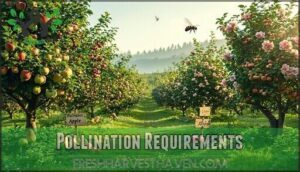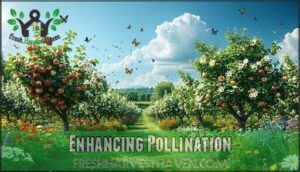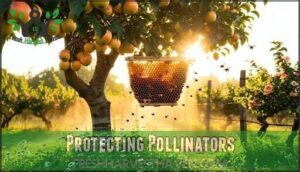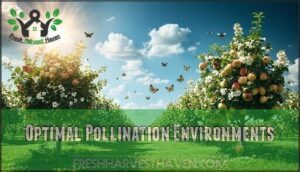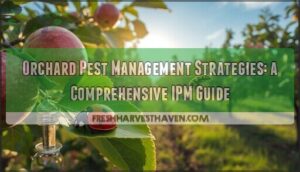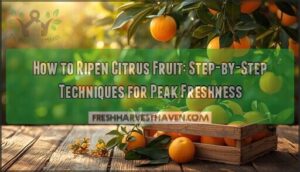This site is supported by our readers. We may earn a commission, at no cost to you, if you purchase through links.
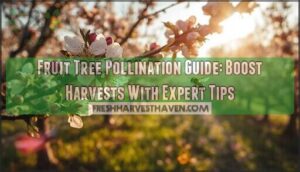
Most fruit trees need cross-pollination from compatible varieties planted within 50 feet—think of it as botanical matchmaking.
Self-fertile trees like some peaches can fly solo, but even they’ll produce better with a buddy nearby.
Bees are your main workforce, transferring pollen between flowers as they hunt for nectar.
Weather matters too—cold snaps during bloom time can ground your pollinator air force.
Plant diverse flowering companions to keep pollinators happy all season long.
Sometimes you’ll need to play cupid yourself with hand-pollination techniques when nature needs backup.
Table Of Contents
- Key Takeaways
- Fruit Tree Pollination Basics
- Pollination Requirements
- Enhancing Pollination
- Protecting Pollinators
- Optimal Pollination Environments
- Frequently Asked Questions (FAQs)
- Do fruit trees need to be pollinated?
- Which fruit trees require a pollinator?
- How do you pollinate fruit trees?
- Can fruit trees be pollinated cross-pollinated?
- What is fruit tree pollination?
- Can a middle flowering fruit tree be pollinated?
- What are the best pollinators for fruit trees?
- How to pollinate fruit trees?
- What are the pollination requirements for fruit trees?
- What fruits can I cross-pollinate?
- Conclusion
Key Takeaways
- Plant compatible varieties within 50 feet – You’ll need cross-pollinating partners like different apple or cherry varieties that bloom simultaneously, since most fruit trees can’t produce quality fruit alone
- Protect your pollinator workforce – You should avoid pesticides during bloom time and create bee-friendly habitats with companion plants, water sources, and native flowers to keep pollinators healthy and active
- Master hand-pollination as a backup – You can use a small brush or cotton swab to transfer pollen between flowers during mid-afternoon hours when natural pollinators aren’t available or weather conditions are poor
- Time everything with weather patterns – You’ll get the best results when temperatures stay between 59°F-77°F during bloom periods, so protect blossoms from frost and provide consistent watering to prevent stress-induced flower drop
Fruit Tree Pollination Basics
Understanding fruit tree pollination transforms your garden from hit-or-miss harvests to abundant yearly crops.
You’ll discover which trees need partners to produce fruit and which varieties can go it alone, making smarter planting decisions that save space and maximize your harvest.
Importance of Pollination for Fruit Production
Without pollination, your fruit trees become decorative plants—beautiful but fruitless.
No pollen, no fruit—your trees stay pretty but empty-handed.
This essential pollen transfer process triggers fertilization, transforming flowers into the fruit you’re hoping to harvest.
Poor pollination techniques directly slash fruit yield and crop quality, leaving you with sparse, undersized produce.
When flower timing aligns with healthy bee health and ideal conditions, the pollination process becomes your orchard’s success story.
Mastering fruit tree pollination means understanding that every bloom represents potential—but only if pollination requirements are met through proper fruit production strategies.
Self-Pollinating Vs Cross-Pollinating Trees
When planning your orchard, self-pollinating trees like peaches and sour cherries produce fruit independently, perfect for limited spaces.
While selfpollinating trees offer convenience, crosspollinating methods typically deliver superior fruit yield and quality.
Choose your tree variety based on available space and desired pollination techniques for ideal fruit tree pollination success, noting that cross-pollinating varieties such as apples and sweet cherries need compatible partners nearby for pollen transfer.
Role of Bees and Other Pollinators
Picture your fruit trees as bustling restaurants where honeybees are the star servers, handling 80% of all fruit tree pollination work.
Honeybees orchestrate nature’s most essential dinner service, transforming blossoms into tomorrow’s harvest.
These incredible insect interactions showcase nature’s perfect pollination ecology system.
Bee behavior reveals fascinating patterns as they move between blossoms:
- Honeybee role: Primary workforce transferring pollen grain by grain
- Pollinator diversity: Native bees, bumblebees, butterflies, and beneficial flies join the effort
- Cross pollination methods: Each pollinator species brings unique flight patterns and preferences
- Pollinator friendly plants: Nearby flowers keep these helpers happy and productive
- Fruit tree pollination: Success depends on healthy pollinator populations visiting your orchard
Your mission? Protect these tiny heroes from pesticides and create welcoming habitats with native plants, shallow water sources, and shelter options.
Flower Anatomy and Pollination Process
Your fruit tree’s flower structure holds the key to successful pollination.
Each bloom contains the stamen (male part producing pollen) and pistil (female part receiving it).
The pollination process follows three essential steps:
- Pollen Transfer – Bees or wind carry pollen from stamen to pistil
- Pollen Viability – Fresh pollen fertilizes the ovary within the pistil
- Fruit Development – Successful fertilization triggers fruit formation
Understanding flower anatomy and pollination biology helps you optimize your orchard’s productivity naturally.
Pollination Requirements
Understanding your fruit trees’ specific pollination needs is essential for maximizing your harvest potential.
Different species require varying distances between compatible varieties and have unique compatibility requirements for successful fruit production.
Spacing Requirements for Different Fruit Trees
Proper tree spacing affects pollen flow between your fruit tree varieties.
Standard apples need 30-35 feet apart, while dwarf trees require just 8-10 feet.
Semi-dwarf varieties thrive at 15-18 feet spacing.
Sweet cherries demand 25-30 feet, but tart cherries need only 20 feet.
Orchard planning with correct tree distance guarantees adequate sunlight and air circulation.
Crowded trees reduce fruit tree pollination success by limiting bee movement and creating poor growing conditions for maximum harvest yields.
Partnering Fruit Trees for Cross-Pollination
Once you’ve figured out proper spacing, choosing compatible pollination partners becomes your next priority.
Fruit pairing requires matching varieties that bloom simultaneously and share genetic compatibility. Variety selection matters because some trees, like triploid apples, can’t pollinate others and need two different partners instead of one.
Cross pollination works best when you plant genetically distinct varieties rather than closely related ones. For successful fruit tree compatibility, research specific pollinatorfriendly combinations before planting.
Think of it as botanical matchmaking—finding the perfect partners guarantees your trees will produce abundant fruit through effective crosspollination.
Optimal Distance for Pollination Success
Getting your Tree Spacing right makes all the difference for successful Cross Pollination. Keep Pollination Partners within this Bloom Radius for ideal Fruit Set.
- Apples: Semi-dwarf trees within 50 feet, dwarf varieties within 20 feet
- Sweet cherries: Different varieties should stay within 20 feet maximum
- Pears: Cross-pollinating varieties work best within 100 feet
- Plums: Compatible varieties need spacing under 100 feet for effective Pollen Transfer
- Blueberries: Plant different varieties no more than 6 feet apart
Remember, bees typically forage within 2-4 kilometers, but closer Fruit Tree Spacing Requirements boost Pollination Distance efficiency substantially. Consider attracting beneficial insects with companion plants to further enhance pollination.
Compatibility of Pollen and Flower Parts
While proper distance matters, pollen compatibility determines whether fertilization actually occurs.
Genetic compatibility between varieties guarantees pollen viability meets stigma receptivity requirements for successful fruit development.
Bloom synchronization maximizes crosscompatibility success:
- Match flowering periods between pollinizer varieties
- Confirm pollen quantity peaks when stigmas are most receptive
- Consider selfpollination capabilities for backup fruit set
- Follow specific pollination requirements for each fruit type
Understanding these fruit tree pollination guide fundamentals prevents wasted blooms and disappointing harvests.
Enhancing Pollination
While some fruit trees naturally self-pollinate, you can substantially boost your harvest by implementing proven enhancement techniques.
Strategic planting of multiple varieties, attracting beneficial pollinators, and creating ideal growing conditions will maximize your fruit tree’s reproductive success.
Planting Multiple Varieties for Cross-Pollination
Strategic variety selection creates pollination partnerships that maximize fruit yield.
You’ll need compatible fruit tree varieties with synchronized bloom times—typically within pollination requirements of 50-100 feet for effective cross pollination.
Understanding tree seed Fruit Tree Seeds options is vital for selecting the right varieties.
| Tree Type | Pollinator Partners |
|---|---|
| Apples | Honeycrisp + Gala |
| Sweet Cherries | Bing + Stella |
| Pears | Bartlett + Anjou |
| Plums | Santa Rosa + Methley |
| Blueberries | Northland + Bluecrop |
Pollen compatibility guarantees successful fruit tree pollination when you match flowering periods correctly.
Using Companion Plants to Attract Pollinators
Companion plants transform your fruit trees into pollinator magnets. Strategic positioning creates bee-friendly environments that boost fruit production naturally.
Top 5 Pollinator Attraction Partners:
- Borage – Increases pollinator visits by 55% with continuous blue blooms
- Lavender – Creates 40% higher bee density in mixed plantings
- Marigolds – Boost pollination rates by 25% while deterring pests
- Phacelia – Supports 20+ native bee species with purple flower spikes
- White clover – Provides ground-level nectar without competing for space
Plant these herb companions in clusters near your trees. Native flowers work best since local pollinators recognize them instantly. Position flower arrangements within 20 feet of fruit trees for maximum impact while avoiding root competition.
Understanding companion plant benefits can help you create a thriving ecosystem.
Hand Pollination Techniques for Indoor Trees
When companion plants aren’t enough, hand pollination becomes your indoor trees’ lifeline. You’ll need pollen brushes or cotton swabs for precise indoor pollination. Target mid-afternoon when flowers are most receptive. Gently transfer pollen from anthers to stigma using circular motions.
Understanding pollination basics is essential for successful fruit production.
| Tool | Best Use |
|---|---|
| Soft brush | Large flowers, multiple transfers |
| Cotton swab | Precise work, small spaces |
| Artist brush | Delicate selffruitful varieties |
This handpollination technique works perfectly for indoor tree pollination when natural pollinators can’t access your fruit tree pollination guide setup.
Creating Pollinator-Friendly Environments
By welcoming nature’s workforce, you’ll transform your yard into a pollinator habitat that guarantees abundant fruit harvests.
Plant native plants and maintain floral diversity throughout growing seasons to support pollination ecology.
Create bee hotels and leave wildflower patches for habitat preservation.
Add shallow water sources and avoid pesticides during bloom periods.
These pollinator-friendly plants establish thriving pollinator gardens that boost pollinator conservation while maximizing your tree’s productivity naturally.
Protecting Pollinators
Your pollinator protection efforts directly impact fruit harvest success, as healthy bee populations guarantee reliable crop yields.
Safeguarding these essential insects requires strategic planning around chemical use, habitat creation, and natural resource management.
Avoiding Chemical Sprays and Pesticides
When you skip pesticides during bloom time, you’re protecting pollinator health and supporting natural pest control.
Chemical sprays can harm beneficial insects that provide essential bee pollination for your fruit trees.
Instead, embrace organic gardening principles by using natural sprays and eco friendly alternatives.
These sustainable methods maintain pollinatorfriendly practices while keeping pests at bay—giving your orchard the best of both worlds.
Using organic sprays can be an effective way to control pests without harming pollinators.
Encouraging Natural Predators and Organic Sprays
Nature’s got your back in terms of natural pest control. Create predator encouragement zones by building brush piles and leaving plant debris for beneficial insects like ladybugs and lacewings.
These allies devour aphids and other pests without threatening pollinator health. When you need organic pesticides, apply biological sprays like neem oil during early morning hours.
This timing protects busy pollinators while maintaining your pest control balance. Pollinatorfriendly gardening means working with nature’s rhythm, not against it.
By adopting pollinator friendly practices, you can create a thriving ecosystem that supports local wildlife and promotes biodiversity.
Providing Water Sources for Pollinators
Hydration drives pollinator success in your garden.
Create pollinator water stations using shallow dishes with pebbles or stones for safe landing spots.
Position these water sources for pollinators near your fruit trees, ensuring fresh water availability throughout the growing season.
Water quality matters—change it every few days to prevent mosquito breeding.
Small fountains or bird waterers work perfectly as pollinator ponds, supporting bee hydration and keeping beneficial insects active around your trees.
Supporting Pollinators’ Life Cycles
Beyond water, you’ll need to support pollinator life cycles through strategic native plants and pollinator habitats.
Create bee conservation zones with bare soil patches for ground-nesting species and install bee hotels for cavity nesters.
Plant diverse pollinator-friendly plants that bloom throughout seasons, providing pollinator nutrition when your fruit trees aren’t flowering.
These ecosystem services strengthen pollination timing and boost your fruit tree pollination guide success naturally.
Optimal Pollination Environments
Creating the perfect conditions for pollination can make or break your fruit harvest.
You’ll need to understand how temperature, weather patterns, and proper tree care work together to maximize your trees’ reproductive success.
Temperature and Weather Conditions for Pollination
Weather conditions determine your fruit tree pollination success. Temperatures between 59°F-77°F that maximize pollination timing are desirable, while frost impact below 28°F damages blooms. Rain effects wash away pollen, and heat stress above 86°F causes sterility.
Protect your trees by taking the following steps:
- Monitor forecasts for frost impact warnings
- Install wind protection barriers during bloom
- Guarantee cold tolerance with row covers
- Maintain climate suitability through proper site selection
Importance of Proper Care to Minimize Flower Drop
Your tree’s flowers are like delicate performers—they need Water Management and Soil Quality just right to stay on stage.
Consistent watering prevents stress-induced flower drop, while balanced Fertilization Methods keep blooms healthy.
Smart Pruning Techniques improve airflow, and timely Pest Control protects blossoms from damage.
Proper fruit tree care creates ideal conditions for successful fruit set and enhanced fruit tree pollination.
Maximizing Fruit Tree Pollination Success
Maximizing fruit tree pollination success starts with strategic planning and tree diversity. Smart orchardists know that bloom synchronization and pollination timing make or break your harvest.
Here’s your action plan:
- Plant compatible varieties within proper spacing distances
- Create pollen quality hotspots with diverse flowering plants
- Use hand pollination strategies during peak bloom windows
- Monitor weather patterns to protect delicate blossoms
These fruit tree pollination techniques boost fruit yield dramatically.
Managing Pollination Challenges and Solutions
Facing pollination challenges with your fruit trees? Poor pollinator health from pesticide use reduces bee activity by 80%.
Weather disruptions and incompatible varieties limit cross pollination success.
Implement pollination strategies like hand pollination and companion planting.
Smart pollen management and diverse hedgerows boost fruit yield by creating resilient fruit tree pollination systems that overcome environmental obstacles.
Understanding proper pollination techniques is essential for maximizing fruit production and addressing these challenges.
Frequently Asked Questions (FAQs)
Do fruit trees need to be pollinated?
Picture vibrant blossoms buzzing with life—that’s your fruit trees calling for help!
Yes, you’ll need pollination for fruit development.
Some trees self-pollinate (peaches, apricots), while others require cross-pollination partners (apples, pears, sweet cherries).
Which fruit trees require a pollinator?
You’ll need pollinators for blueberries, pears, apples, plums, and sweet cherries. These trees can’t produce fruit alone—they require a different variety nearby for cross-pollination to occur successfully.
How do you pollinate fruit trees?
You’ll pollinate fruit trees naturally through bees and wind, or manually using a small brush to transfer pollen between compatible blooms during peak flowering hours.
Can fruit trees be pollinated cross-pollinated?
Over 80% of fruit trees rely on cross-pollination for maximum yields.
You can cross-pollinate by planting compatible varieties within 100 feet, attracting bees with companion flowers, or hand-pollinating using a small brush during peak bloom times.
What is fruit tree pollination?
Transferring pollen between flowers triggers fertilization, enabling your trees to develop delicious fruit. You’ll need compatible varieties nearby for cross-pollinating species, while self-fertile trees handle everything independently.
Can a middle flowering fruit tree be pollinated?
Yes, you can pollinate middle flowering fruit trees by pairing them with compatible varieties that bloom simultaneously.
The key’s matching flowering windows—early, middle, or late bloomers work within their respective timing groups effectively, which is crucial for successful pollination with compatible varieties.
What are the best pollinators for fruit trees?
Buzzing bees brilliantly boost your fruit tree yields.
Honeybees handle 80% of pollination work, while bumblebees and native solitary bees provide backup.
You’ll also benefit from butterflies, moths, and beneficial insects visiting your blossoms during peak flowering periods.
How to pollinate fruit trees?
You’ll need compatible varieties blooming simultaneously within 100 feet. Plant pollinator-friendly flowers nearby, avoid pesticides during bloom, and use hand-pollination with brushes when natural pollinators aren’t available.
What are the pollination requirements for fruit trees?
Fruit trees fall into two camps: self-pollinating varieties like peaches and sour cherries that’ll fruit solo.
And cross-pollinating types like apples and sweet cherries that need compatible partners nearby to produce fruit successfully.
What fruits can I cross-pollinate?
Picture your orchard buzzing with cross-pollination possibilities.
You can cross-pollinate apples with different apple varieties, pears with other pears, plums with compatible plums, and sweet cherries with different sweet cherry cultivars within proper spacing distances to facilitate effective pollination.
Conclusion
Ironically, the most productive fruit growers often forget that their trees can’t reproduce alone—they need a matchmaker.
This thorough fruit tree pollination guide has equipped you with everything needed to transform your orchard into a buzzing paradise.
You’ve learned about cross-pollination partnerships, ideal spacing, and hand-pollination backup plans.
You understand how weather affects your pollinator workforce and why companion plants matter.
Now you’re ready to boost harvests by creating the perfect environment where trees, bees, and gardeners work together in sweet harmony.

